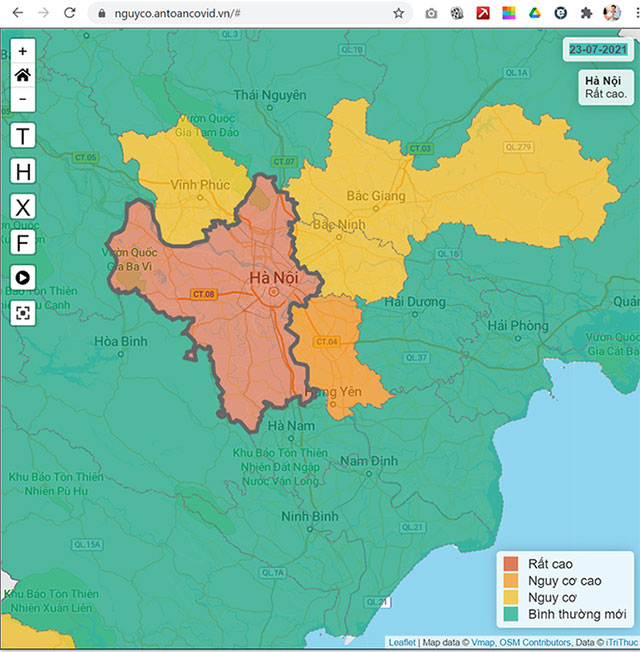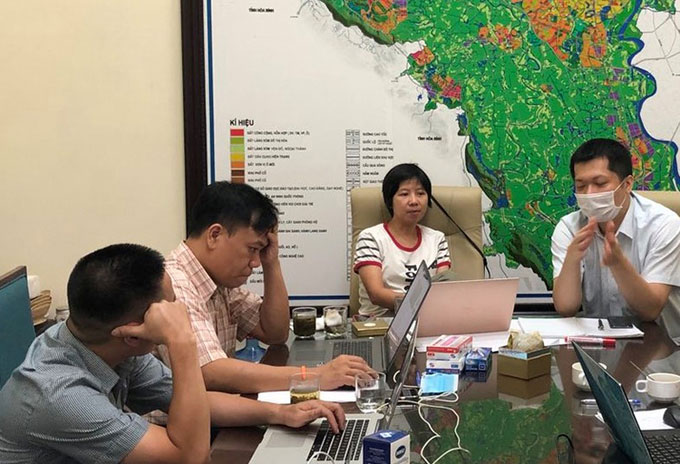On July 22, the Covid-19 risk warning map in Hanoi changed from yellow to red. The following day, Deputy Prime Minister Vu Duc Dam discussed the situation with Hanoi Chairman Chu Ngoc Anh.
The red color indicates that the risk of disease spread in the capital is “Very High” – the highest level in the four warning levels set by the Rapid Response Information Team of the National Steering Committee for Covid-19 Prevention.
Mr. Nguyen The Trung, a member of the Rapid Response Information Team, stated that data from July 22 revealed that two infection chains at Tam Duc Pharmacy (Lang Ha) and a group of individuals undergoing self-testing were growing larger and becoming difficult to control, with a risk of spread exceeding 50% across districts.
Based on experiences gathered during the pandemic response, the team concluded that when the number of new F0 cases in 14 days exceeds 1 per 100,000 population, it indicates a risk. At this time, Hanoi had a rate of 4.43 per 100,000 population – a concerning level. An analysis of data from each district also showed that there are 7 districts classified as “High Risk” and 20 out of 30 districts classified as “Risk.”
Based on this data, the team immediately reported to the Head of the National Steering Committee, Deputy Prime Minister Vu Duc Dam (who was then working in Ho Chi Minh City) and the Head of the Hanoi Steering Committee, Chairman Chu Ngoc Anh. The warning data closely matched the assessment of the Covid-19 prevention steering committee in Hanoi, as the area recorded the highest number of positive cases since the beginning of the fourth outbreak on July 22 and 23. “Later, I learned that by the end of the morning of July 23, Deputy Prime Minister Vu Duc Dam had texted and called to work with city leaders, agreeing to implement Directive 16 in Hanoi as soon as possible,” Mr. Trung shared.
After a process of working and discussing various preparatory options, the agencies reached a consensus to apply citywide social isolation according to Directive 16 on the night of July 23.

The Very High Risk warning map in Hanoi on July 23. Residents can check the risk map at nguyco.antoancovid.vn.
The Covid Safety Risk map was developed over a year ago, with an analytical center located at the Government Office. The map presents four levels of disease warning: New Normal (green); Risk (yellow); High Risk (orange); Very High (red). The team sends daily reports to the National Steering Committee for Covid-19 Prevention and local authorities, forecasting risks down to the commune level.
The warning levels are based on data analysis regarding outbreaks, the relationships between outbreaks, the structure of contact groups, and the severity of patient symptoms… The team employs statistical epidemiological models, machine learning, knowledge networks, and expert knowledge to answer questions such as: what is the risk of an area, where are the significant outbreaks, how are they developing, where are potential super-spreader locations, and how capable is the locality in responding…
The team also gathers evaluations from experts in epidemiology, sociology, mathematics, and information technology from leading institutes and universities such as the Central Institute of Hygiene and Epidemiology, Hanoi Medical University, Vietnam National University Hanoi and Ho Chi Minh City, Hanoi University of Science and Technology, Thuy Loi University, and the Institute of Advanced Mathematics…
“Data analysis is conducted multidimensionally for cross-evaluation to provide practical yet theoretically sound answers,” Mr. Trung stated.
According to Mr. Trung, there were times when the information team faced more specific questions such as: why choose 19 provinces instead of 22 or 24 provinces to implement Directive 16? Can the outbreak in a certain area be contained? Which wards or housing clusters are at high risk?…
“Usually, after gathering data, we have a night to analyze and prepare a report, but in urgent situations, we only have 1 hour, or even 15 minutes to answer questions,” Mr. Trung said.

Mr. Nguyen The Trung (second from left) and the expert team in the Rapid Response Information Team analyzing data on May 22. (Photo: NVCC).
The Rapid Response Information Team currently consists of 300 scientists, experts, and volunteers in epidemiology and information technology. “Through our experience in pandemic response, we increasingly believe in the interdisciplinary theory that data can aid in management,” Mr. Trung remarked.



















































